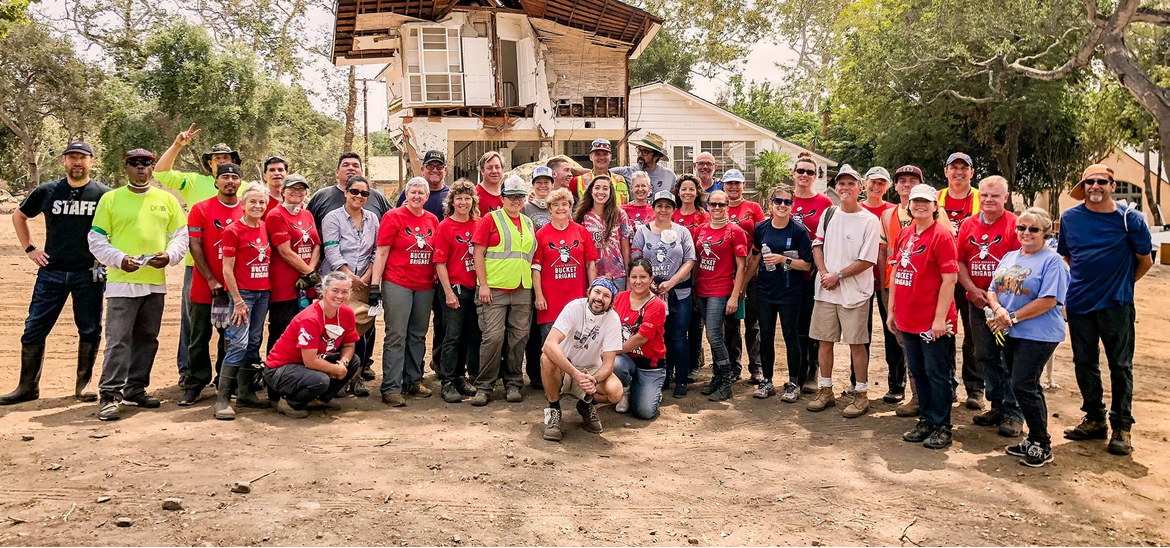Bucket Brigade Launches Resiliency Plan

On Monday, December 9, at Montecito Hall, Bucket Brigade co-founder Abe Powell hosted a Resiliency Workshop in order to roll out the organization’s newest mission: to help neighborhoods build hyper local resiliency in Montecito and beyond. “We are in a time where there is a huge opportunity for neighborhoods to build resilience, in what we think is a profound time of need in California,” Powell said to the two dozen attendees at the meeting.
Powell reported what many in Santa Barbara County already know: that wildfires are happening more often, and more intensely, than ever before. “In 2017, we learned that something has changed in Santa Barbara County,” said Powell. “We saw the longest period of sundowner winds that we’ve ever experienced, the lowest relative humidity, and the lowest fuel moistures, resulting in [what was then] the largest wildfire in California history: the Thomas Fire,” he said. He went on to show a slide of the temperature change in California since 1895 recently released by the Washington Post, which reports that the temperature in Santa Barbara County has warmed by 2.3 degrees. The article notes that temps in Ventura County have increased by 2.6 degrees, making it the “fastest-warming county in the lower 48 states.” “We’re experiencing something that’s radically different than what we’ve seen before,” said Powell, who also serves on the Montecito Fire Protection District Board of Directors.
The Bucket Brigade was formed following the 1/9 debris flow, when a handful of neighbors organized themselves to help dig out over 100 damaged or destroyed properties, raising $1.2M for disaster relief in the process. “We started with five people, and eventually organized over 3500 volunteers,” Powell said. “Five organized people in your neighborhood can act as a powerful multiplier.”
The group has continued to serve the community by acting as a disaster preparedness advocate, building a walking path along North Jameson Lane, launching a Youth Leadership program to help local teens meet their community service hours, creating custom memorial benches for each victim of the debris flow, and continuing to help search for two missing children – two-year-old Lydia Sutthithepa and 17-year-old Jack Cantin – whose remains have never been found following the 1/9 disaster.
Powell explained that a community goes through several phases of recovery following a disaster, including immediate response and mitigation, short-term and then long-term recovery, assessment of “what’s next,” planning, preparation, and then collective amnesia. “There are several gaps in service during the recovery process, which community resilience can address,” Powell said, adding that it’s not the local government’s job to create a resilient community, but instead it’s the responsibility of local neighborhoods to be prepared for disasters and beyond. “Your neighbors have a common interest in neighborhood resilience: you are all in it together when a disaster strikes,” he said, recalling that during the Tea Fire, neighbors in the Mountain Drive area, who were well organized, were able to save the lives of several people who were unaware that a fire was approaching. “Often there is not enough time for first responders to knock on every door to tell people to evacuate,” he said. “It’s up to you and your neighbors.”
Resiliency can include many things, including disaster prevention or hardening; insurance policy assistance; planning and preparation education; short term housing; emotional/psychological support; financial/material support, long term housing; neighborhood directories; recovery assistance workdays; insurance claim assistance; effective bargaining for construction rebuilding; and rebuilding assistance with planning and permitting.
The Bucket Brigade is launching a 5-Step Neighborhood Action Kit, designed to empower local areas to increase resiliency. The five-step plan includes defining the neighborhood, recruiting neighbors (leaders and “worker bees”), identifying risks and assets in the neighborhood, building a team (forming committees and agreeing on scope of work), and making a plan for evacuations, shelter-in-place events, disaster prevention and preparedness, as well as recovery. Some easy ideas to create resiliency locally include: form a community directory in order to communicate with each other easily; work together to reduce dangerous conditions in the neighborhood; improve safety on local roads for pedestrians and bicyclists, as well as defensible space from fire; provide educational opportunities such as CPR, first aid, and CERT classes; and improve public spaces, among other things.
The Bucket Brigade will host trainings and workshops in the coming year to help neighborhoods organize, and provide support once groups are formed.
“A grassroots capacity doesn’t build itself, we are here to help,” Powell said. Stay tuned for a series of classes beginning in February, to go over the “nuts and bolts” of forming neighborhood groups. For more information, visit www.sbbucketbrigade.org.





